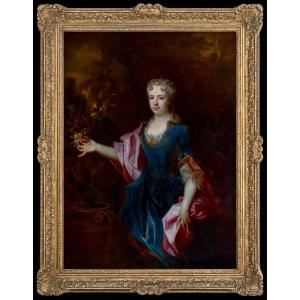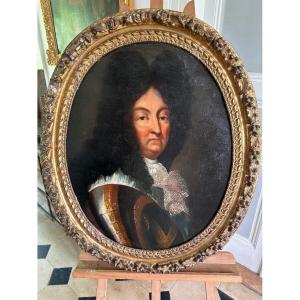In the first quarter of the 17th century a new form of flower painting was developed in Flemish painting, which, recreated by a large group of artists and workshops, would achieve considerable success throughout the century in much of Europe: the garland of flowers surrounding a central figure. Brueghel de Velurs was the initiator of this type of composition, however, it was his pupil, Daniel Seghers, who was the dominant figure in this specialised production and the creator of a prototype that would serve as a model for the numerous artists who followed in his wake. It seems undeniable that the artist of the present painting had seen the Garlands of Flowers Surrounding a Medallion Depicting the Triumph of Love by Daniel Seghers and Domenico Zampieri (now in the Musée du Louvre in Paris).
In our painting, the present floral wreath encircles a carved cartouche within which sits Saint Dorothy of Caesarea and the attribute which often accompanies her in art, a basket of roses. The extremely delicate flowers have been rendered in meticulous detail, so that every species can be identified from exotic tulips to roses, irises and forget-me-nots; this obvious attention to naturalism is inherited from the Flemish manner. Each flower is so precise and refined that they are an individual study in their own right.
The still-lifes are from the hand of Jan Anton van den Baren, with the central figures by another accomplished hand. Van den Baren’s arrangement of flowers would have delighted connoisseurs in both Flanders and in Vienna, where the impossibility of their all blooming at the same time of year would have been understood as a further statement of the wonder and beauty of the divine.
Van den Baren worked first in Brussels, where he collaborated with Erasmus Quellinus II for the figures in his works, before moving with Archduke Leopold Wilhelm, his patron, to Vienna in 1656, where he instead worked with fellow Flemish émigré painter Nikolaus van Hoy. The iconography relates to an eighth century legend where she was presented a basket of roses by a child.
In addition to the brilliance of his handling of still-lifes Van den Baren played an important art historical role as Director of Archduke Leopold Wilhelm’s Picture Gallery in Vienna, then one of the greatest collections in the world and the core of what was to become the present collection of the Kunsthistorisches Museum, Vienna. Van der Baren compiled an inventory of the collection in 1659, and his predecessor as Director of the Archduke’s Picture Gallery (when it was still housed in Flanders), David Teniers, depicted van der Baren (third from right) in his celebrated Archduke Leopold Willem in his gallery at Brussels, conserved at the Kunsthistorisches Museum.
It is a shining example of the Flemish Baroque and is a very rare object indeed, considering there are only 14 paintings accepted as authentic works by this artist.
We are grateful to Fred Meijer for confirming the attribution to Johannes Antonius van der Baren.
A feature of this painting is its outstanding carved and gilded frame with a plethora of flowers and foliage.

















































 Le Magazine de PROANTIC
Le Magazine de PROANTIC TRÉSORS Magazine
TRÉSORS Magazine Rivista Artiquariato
Rivista Artiquariato